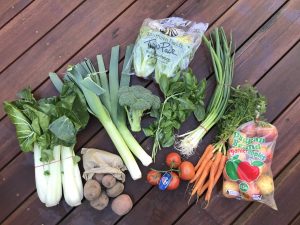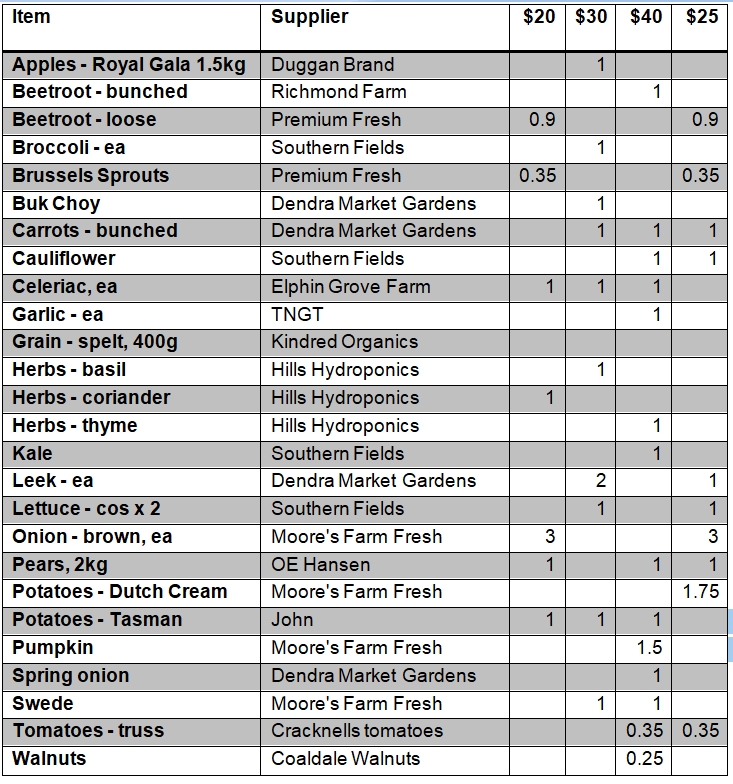 This week’s boxes feature an array of herbs – which if I’m honest wasn’t the intention, but our original order for almost 300 bunches of thyme from Hills Hydroponics, our major herb supplier based on the north coast of Tasmania, hit a snag and so we needed to split it three ways between thyme, basil and coriander!
This week’s boxes feature an array of herbs – which if I’m honest wasn’t the intention, but our original order for almost 300 bunches of thyme from Hills Hydroponics, our major herb supplier based on the north coast of Tasmania, hit a snag and so we needed to split it three ways between thyme, basil and coriander!
The word herb is complicated – from a botanical point of view it signifies the lack of a woody stem and includes the grasses that herbivores eat, but in culinary or medicinal terms it can include a wide range of plants that meet two criteria: a) it provides flavour or performs a physiological function, and b) the leaf is the part of the plant that is used in this application (this latter point distinguishing herbs from spices). Herbs are generally perennials (like thyme), although they can be annuals (like basil and coriander); they generally die back in the cooler months of the year, and traditionally dried herbs were used in winter dishes for this reason, but the use of large hothouses and hydroponic techniques allows Hills Hydroponics to supply herbs most of the year.
 Soft-leafed herbs like basil and coriander tend to be best used raw or in pastes to obtain optimum flavour. Whilst basil tends to be associated with Italian food and coriander with Asian dishes, the geographical area that the two herbs are native to largely overlaps and includes most of southern Europe and Asia. Basil is great in Asian dishes – one of my favourite options is a paste of chilli, basil and shrimp paste – and although coriander is a welcome and ubiquitous garnish on all sorts of curries, I’m quite fond of a Greek lamb bake that uses coriander leaf in conjunction with white wine and tomatoes, topped with a yoghurt, cheese and egg topping with heaps of nutmeg. (Interestingly, coriander is both a herb and a spice – the herbs is the leaf of the plant, but when, inevitably, it goes to seed, the seed is also a sought after spice commonly used in curry powders.)
Soft-leafed herbs like basil and coriander tend to be best used raw or in pastes to obtain optimum flavour. Whilst basil tends to be associated with Italian food and coriander with Asian dishes, the geographical area that the two herbs are native to largely overlaps and includes most of southern Europe and Asia. Basil is great in Asian dishes – one of my favourite options is a paste of chilli, basil and shrimp paste – and although coriander is a welcome and ubiquitous garnish on all sorts of curries, I’m quite fond of a Greek lamb bake that uses coriander leaf in conjunction with white wine and tomatoes, topped with a yoghurt, cheese and egg topping with heaps of nutmeg. (Interestingly, coriander is both a herb and a spice – the herbs is the leaf of the plant, but when, inevitably, it goes to seed, the seed is also a sought after spice commonly used in curry powders.)
Thyme – which is hardier and arguably does have stem verging on woody – is definitely suited to cooking, imparting its deliciously savoury notes to slow-cooked stews and broths. Whilst coriander and basil definitely live in the fridge, thyme will dry easily and once dry will store pretty much forever; just hang it up in a dry spot with plenty of air flow in the bunch it comes in. It’s most commonly used in European dishes, although it’s also a welcome addition to a big pot of chilli beans, along with a stick of cinnamon – both excellent infusers. If you want to just use the leaves of thyme, the easiest way is to grip the stem loosely at the top end between two fingers, and then pull them along the length of the stem against the direction of the leaves. (This sometimes works for basil but sadly not all the time, and it can bruise the leaves in the process.)

